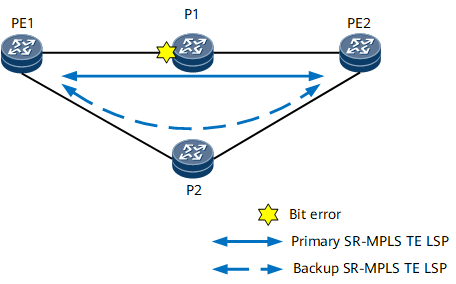Bit-Error-Triggered SR-MPLS TE LSP Switching
Background
SR-MPLS TE LSP establishment does not require protocols. Therefore, an SR-MPLS TE LSP can be established as long as a label stack is delivered. If an SR-MPLS TE LSP encounters bit errors, upper-layer services may be affected.
To cope with link bit errors along an SR MPLS-TE tunnel and reduce the impact of bit errors on services, deploy bit-error-triggered SR-MPLS TE LSP switching. After this function is enabled, service traffic is switched from the primary SR MPLS-TE LSP to the backup SR MPLS-TE LSP if bit errors occur.
Implementation Principles
On the network shown in Figure 1, bit error detection must be enabled on the PEs along the SR MPLS-TE tunnel. If static BFD detects bit errors on the primary LSP of the SR-MPLS TE tunnel, it instructs the SR-MPLS TE tunnel to switch traffic from the primary LSP to the backup LSP. This minimizes the impact on services.
The SR MPLS-TE tunnel is unidirectional. To detect bit errors on the LSP from PE1 to PE2, enable bit error detection on PE1. To detect bit errors on the LSP from PE2 to PE1, enable bit error detection on PE2.
Usage Scenario
If an SR MPLS-TE tunnel is used as a public network tunnel, deploy bit-error-triggered SR MPLS-TE LSP switching to cope with link bit errors along the tunnel.
